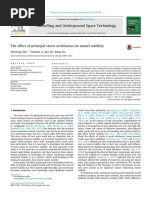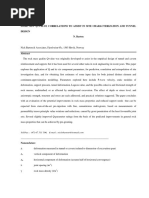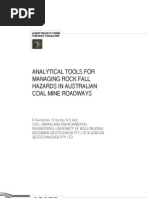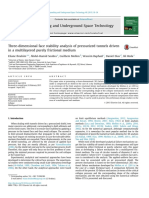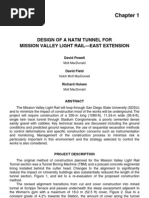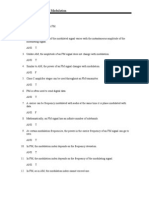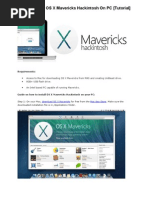Tunnel Full Paper Id Number 306
Tunnel Full Paper Id Number 306
Uploaded by
Bosko SarenacCopyright:
Available Formats
Tunnel Full Paper Id Number 306
Tunnel Full Paper Id Number 306
Uploaded by
Bosko SarenacCopyright
Available Formats
Share this document
Did you find this document useful?
Is this content inappropriate?
Copyright:
Available Formats
Tunnel Full Paper Id Number 306
Tunnel Full Paper Id Number 306
Uploaded by
Bosko SarenacCopyright:
Available Formats
SEE Tunnel:Promoting Tunneling in SEE Region
ITA WTC 2015 Congress and 41st General Assembly
May 22-28, 2015, Lacroma Valamar Congress Center, Dubrovnik, Croatia
Evaluation of applied SFRC as a steel replacement in the design
stage in a part of Cairo Metro line No. 4
Taher ELSAMNI, Nippon Civic Consulting Engineers Co. LTd., Tokyo, Japan, taher-el@nccnet.co.jp
Ashraf ABU-KRISHA, National Authority for Tunnels, Cairo, Egypt, ashamk66@hotmail.com
Takayoshi OTSUKA, Nippon Civic Consulting Engineers Co. LTd., Tokyo, Japan, otsuka@nccnet.co.jp
Kazuto FUJII, Nippon Civic Consulting Engineers Co. LTd., Tokyo, Japan, fujii@nccnet.co.jp
Topic: Planning and Designing Tunnels and Underground Structures
KEYWORDS: Steel Fiber, lining, Tunnel, Concrete, Crack, Ductility
1. Introduction
Apart from development in machine technology and other cross sectional tunnel shapes, the
alternative lining systems. It has carried out as well, in early sixties in the former Soviet Republic
experiments were carried out with tunnel lining without any joints [1] after excavation; the soil was
replaced by in site poured concrete lining. At the end of the seventies and beginning of the eighties
German and Japanese contractors further development the principle with idea to improve the
following points [2]:
1 No secondary lining any more
2 Reducing the settlements
3 Improve the quality and behavior of the tunnel lining
4 Reduction of the construction cost by increase in construction speed
5 Developing the lining material. That which our aim of this technical paper
2. Paper aims and objectives
The main goal of this paper is to describe a design approach and evaluate the steel fiber reinforced
segment for application in a part the underground of line No. 4, Cairo, Egypt. Background of the
study that the Greater Cairo Metro line No. 4 phases 1 running
from a depot/workshop via the Grand Egyptian Museum (GEM)
to Elmalek Elsaleh Station with a length of 17.0 km, in a very
dense sand soil, the designer propose to extend phase 1 by
approximately 1.0km to solve some problem in the alignment
and land acquisition, the area which is proposed to construct
locate at the Muqattam Plateau, which is line stone, the cross
section shown in Figure No.1. In addition, the feasibility study
of phase 2 of the same line is almost rest in lime stone ground
condition, that leads the designer to think of apply steel fiber
reinforcement in the extended length which is about 600.0m.
On the other hand, to reach a higher mechanical strength in
terms of toughness, flexural and shear design stresses.
Improved damage resistance during transportation and
placing, improve durability in aggressive environments.
Figure 1: Tunnel through the Lime Stone
Section 17k960m [1]
3. Design of section
3.1 The groundwater level
Fluctuations of Nile River; the maximum probable water level (17.33m), the minimum probable
water level (15.55m) =1.8m, thus, the applied level in design is 25.07m-1.8m = 23.27m [1] .
1 / 10
SEE Tunnel:Promoting Tunneling in SEE Region
ITA WTC 2015 Congress and 41st General Assembly
May 22-28, 2015, Lacroma Valamar Congress Center, Dubrovnik, Croatia
3.2 Soil properties
Soil properties in the design are shown in the Table 1 [1], it is proposed to carry out design using
nearest borehole data, which was carried out to collect soil layer information of cross section.
Table 1: Soil properties [1]
Soil layer
FILL
Top Clay
Sand1
Sand2
Sand3
Bottom Clay
Limestone
(yellowish gray)
Limestone
(Bluish gray)
Mudstone
C (kN/m2)
--68
------269
Internal
Friction
angle
()
33.0
--37.0
38.0
41.0
---
(kN/m2)
25,000
11,400
92,500
143,300
250,000
37,400
0.35
0.48
0.35
0.32
0.30
0.45
22.0
300
40.0
300,000
0.30
23.0
300
40.0
300,000
0.30
22.0
100
30.0
150,000
0.40
N
value
Unit
weight
Cohesion
10
10
37
57
100
63
(kN/m3)
19.0
19.0
19.0
21.0
22.0
19.0
Youngs
modulus
Poissons
ratio
4. Tunnel lining properties
-
Segment lining, Type of segment reinforced concrete segment
tenon type segment as shown in the Figure No. 2, outer
diameter of segment lining=6.40 m, thickness of segment
=0.3 m, width of segment =1.50 m, No. of Division of segment
ring=6 (=3A-type+2B-type+K segment inserted in longitudinal
direction), Concrete joint with inclined 2 bolts per joint, Elastic
modulus of segment =3.15107 kN/m2
Concrete specifications according to ECP203/2007, design
basic strength fck = 40 N/mm2, Modulus of elasticity Ec
31.5 kN/mm2, sulphate resistance cement
Normal black hooked steel fiber, L=30mm
diameter=0.5mm, Material satisfied the standard JIS G
3505[2], Mix rate of a steel fibre 0.4vol.%
Shear spring constant between segment rings in
Beam-spring model is calculated using the compressive
rigidity of share strip material. Shear strip material is
setting at ring joint. Figure 2, shows the details of shear
strip position. Radial direction shear spring constant (ksr) of
this segment lining is ksr = 34,500kN/m. For there is no
restraint between segment rings, the tangential shear
spring constant (kst) of this segment lining is 0.0 kN/m.
Figure 2: Ring joint of segment
(Circumferential joint)
5. Loadings
300
Spreader
Loadings of segment lining are carried out in
accordance with the Standard Specifications
for Tunneling [3]. Load combination between
the earth pressures (effective stress method),
dead weight of lining, effective of
surcharge, soil reaction*, earthquake,
effective of multiple parallel tunnel construction
as shown in Figure 1, influence of vicinal
construction, and the extra moment generated
Segment
Thrust jack
2 / 10
Skin plate of TBM
Figure 3: Ring joint of segment
SEE Tunnel:Promoting Tunneling in SEE Region
ITA WTC 2015 Congress and 41st General Assembly
May 22-28, 2015, Lacroma Valamar Congress Center, Dubrovnik, Croatia
from the jack thrust (P=2500kN) as a construction load as shown in Figure 3. Coefficient of soil
reaction, k, at lime stone to be set up k=10MN/m3 as the max value of past records, because of
youngs module at lime stone is E=300,000kN/m2, and Mudstone which is E=150,000N/m2.
*Soil reaction, in this case, N-value at lime stone is over 50. The coefficient of soil reaction (k) which
is over 50 N-value is calculated by the following equation which is adapted from Japan Road
Association, [4]
K H K Ho (
BH 3 / 4
4.525 3 / 4
)
a 1000000 (
)
1.3 100MN / m3
0.3
0.3
Where, shape factor a is 1.3 and
BH
Do 6.4
4.525m
2
2
K Ho
Eo
300000
1
1000000kN / m3
0.3
0.3
As a result, the coefficient of soil reaction (k) =100MN/m3.
6. Relationship between stress of the tensile side and strain of SFRC
component
The stress-strain curve, which is usually obtained by dividing the load by original cross section, and
displacement by original length, can neither be classified as perfectly elastic-brittle, nor as perfectly
elastic- plastic, thus leads to utilized an elastic softening formulating [5], Figures 4 and 5 shown the
tensile softening curve plots the relation between tensile stress and opening width of crack.
Figure 4: Fracture processing zone[5]
Figure 5: Tension softening curve[5]
In this design, the opening width of crack was
converted to strain [6]. The conversion of
1.31
tensile stress to strain is defined the proportion
to Young's modulus before occasion of crack of
concrete, and after occasion of crack, the
relation between strain and the opening
width of crack is defined based on equivalent
length Leq and converted to the relation
between tensile stress and strain. Hereby,
strain=, opening width of crack=w, and
equivalent length=Leq are shown as =w/ Leq.
The equivalent length Leq taken as average
crack spacing and it is relevant to the high,
shape. Where the tensile softening curve of
segment based on the curve of the Figure 4,
therefore, the equivalent length Leg is based
Figure 6: Relationship between height of segment
on the curve of the Figure 6 [6]. With the
and Leq[6]
height of segemnt equal to 300mm, the
Leg/h= 1.31, this value will be used in the following equation to check the maxium allowabe strain
not be cxceed to ultimate strain of concrete which is = 0.002 as shown in the Figure 7 [6].
Ec
cr And,
f 0 w
cr
Ec
Leq
3 / 10
SEE Tunnel:Promoting Tunneling in SEE Region
ITA WTC 2015 Congress and 41st General Assembly
May 22-28, 2015, Lacroma Valamar Congress Center, Dubrovnik, Croatia
The relation of tensile stress and strain
which was used in verification of ultimate
limit state in this design is shown as
Figure 7.
Figure 7: Actual tensile stress-strain
curve
7. Design methodology for
segment lining
Structural calculation in the transverse direction of segment lining is assumed to the Beam-spring
model as shown Figure 8. The Beam-spring method has a current method and features for
calculating member forces as follows:
- Reasonable modeling of the performance of staggered arrangement using rotational rigidity
for segment joints and shear rigidity for ring joints
- Modeling of realistic behavior is possible compared to the other calculation method.
- Member forces at ring joints can be obtained from this pseudo three-dimensional analysis.
Beam(EI,E
A)
Soil
reaction
Rotational
spring
spring
Shear
spring
Ring
Ring
Figure 8: Beam-spring Model (Joint stiffness reduced)
Design condition of Segment lining
E
: elastic modulus of segment (kN/m2)
I
: moment of inertia of segment (m4)
A
: area of cross section of segment (m2)
k
: rotational spring between segment pieces
ksr
: radial shear spring between segment rings
kst
: tangential shear spring between segment rings
k
: coefficient of sub grade reaction
8. Rotational spring constant between segments
Figure 9 shows the rotational spring constant model with inclined bolt between segments is
calculated based on the theoretical equation for concrete coupling [7].
4 / 10
SEE Tunnel:Promoting Tunneling in SEE Region
ITA WTC 2015 Congress and 41st General Assembly
May 22-28, 2015, Lacroma Valamar Congress Center, Dubrovnik, Croatia
Section stress
distribution
Deformation segment joint
Thickness
segment
Figure 9: Model of segment joint as
concrete joint
9a 2 b E C
K
m(1 2m)2
8
Where,
K: Rotational spring constant (kNm/rad), a: Width of coupling contact surface (m) 0.140
Ec: Modulus of elasticity of concrete (kN/m2) 3.15107
m:=Mj / (Nja) Eccentricity rate, Mj: Bending Moment of coupling (kNm)
Nj: Axial force of coupling (kN)
9. Verification items
Table 2 gathers all items that must be verified before allowing to apply the SFRC in lining tunnel in
the project.
Table 2: Check points at the ultimate and serviceability limit state
Part
Action force
Segment
body
Axial force and/or
Bending moment
Ring joint
Shear force
Shear capacity at shear plane of concrete.
Segment
joint
Axial force
Splitting stress (tensile stress) caused by axial force
get to the tensile strength of SFRC member.
Segment
body
Axial force and/or
bending moment
Compressive stress of SFRC member shall be limited
not to exceed 0.4fck. Tensile stress of SFRC shall be
limited not to exceed flexural cracking strength.
Segment
joint
Axial force and/or
bending moment
Compressive stress of concrete shall be limited not to
exceed 0.4fck. *
Ultimate
limit state
Serviceability
limit state
Limit state
1) Acting axial force only, compressive stress at the
compression gets to the ultimate compressive
strain of SFRC member
2) Acting axial force and bending moment
- Depth of cracks is under 0.7h,
- Depth of cracks gets to 0.7h
Where h represents height of the member.
5 / 10
SEE Tunnel:Promoting Tunneling in SEE Region
ITA WTC 2015 Congress and 41st General Assembly
May 22-28, 2015, Lacroma Valamar Congress Center, Dubrovnik, Croatia
10.
Input data
Table 3 shows the all input data with the applied safety factor, for the ultimate limit state and
serviceability limit sate.
Table 3: Input data
Items
Elastic Modulus
of Segment
Area of Cross
Section of
Segment
Moment of
Inertia of
Segment
Diameter of
central line of
Segment
Rotational
Spring Value
Radial shear
spring between
segment rings
Tangential
shear spring
between
segment rings
Vertical earth
pressure
Lateral earth
pressure at
tunnel crown
Lateral earth
pressure at
tunnel bottom
Water pressure
at tunnel crown
Water pressure
at tunnel
bottom
Dead weight
Coefficient of
subgrade
reaction
Coefficient of
lateral earth
pressure
Input Data
Ultimate Limit State
Serviceability Limit State
Main
Safety
Applied
Main
Safety
Applied
value
Factor
value
value
Factor
value
Symbol
Unit
E
kN/m2
3.15107
--
3.15107
3.15107
--
3.15107
A
m2
0.45
--
0.45
0.45
--
0.45
I
m4
3.37510-3
--
3.37510-3
3.37510-3
--
3.37510-3
Dc
m
3.05
--
3.05
3.05
--
3.05
k
kN X m/rad
63,100
33,900
0
--
63,100
33,900
0
63,100
33,900
0
--
63,100
33,900
0
kr
kN/m/Ring
34,500
--
34,500
34,500
--
34,500
kt
kN/m/Ring
--
--
pvc
kN/m/Ring
124.32
1.0
124.32
124.32
1.0
124.32
qe1
kN/m/Ring
44.47
1.0
44.47
44.47
1.0
44.47
qe2
kN/m/Ring
86.00
1.0
86.00
86.00
1.0
86.00
pw1
kN/m/Ring
281.55
0.9
253.40
281.55
1.0
281.55
pw2
kN/m2/Ring
373.05
0.9
33.75
373.05
1.0
373.05
g1
KN
11.70
1.0
11.70
11.70
1.0
11.70
k
kN/m/Ring
150000
0.9
135000
150000
1.0
150000
kN/m/Ring
0.35
1.0
0.35
0.35
1.0
0.35
6 / 10
SEE Tunnel:Promoting Tunneling in SEE Region
ITA WTC 2015 Congress and 41st General Assembly
May 22-28, 2015, Lacroma Valamar Congress Center, Dubrovnik, Croatia
11.
Result of verification at ultimate limit state
The result of verification of the flexural capacity of main part of segment of an ultimate limit state is
shown in Figure 10, as well as from the data in the Table 3, it is clear that the value obtained by
multiplying the ratio of the structure factor to the design force is not greater than 1.0, therefore, it is
confirmed that tunnel lining for Greater Cairo Metro Line No.4 can be satisfied by the SFRC instead of
normal steel reinforcements.
12000
Axial force, N (kN)
10000
8000
6000
4000
2000
0
-2000
-600
-400
-200
200
400
600
Bending moment, M (kNm)
Figure 10: Bending moment and axial force diagram in ultimate limit state
Table 3: Result of reviews of segment body in ultimate limit state
Design bending moment, Md
Design axial force, N'd
kN
Structure factor, i
Positive bending
moment
kNm
-
1092.69
1.2
iMd
kNm
45.86
Ultimate moment, Mud
kNm
152.224
kNm
0.30
O.K.
-33.73
Result, iMd/Mud<1
Design bending moment, Md
Negative
bending moment
38.22
Design axial force, N'd
kN
1214.73
Structure factor, i
iMd
Ultimate moment, Mud
kNm
kNm
1.2
-40.48
165.310
Result, iMd/Mud<1
0.24
7 / 10
SEE Tunnel:Promoting Tunneling in SEE Region
ITA WTC 2015 Congress and 41st General Assembly
May 22-28, 2015, Lacroma Valamar Congress Center, Dubrovnik, Croatia
Result of verification at serviceability limit state
Verification is carried out by the
confirmation that cracks the
serviceability limit state are below
generating flexural capacity by
drawing of N-M interaction curve.
N-M interaction curve is shown in.
Figure 11, the verification result at
serviceability limit state is shown in
Table 4.
However, considering the accident
such as dropping of segment, the
minimum reinforcement bar shall
be installed in SFRC segment
lining.
8000
7000
6000
Axial force, N (kN)
12.
5000
4000
3000
2000
1000
0
-1000
-2000
-300
-200
Figure 11: Bending moment and
-100
100
200
300
Bending moment, M (kNm)
axial force diagram of segment body in serviceability limit state
Table 4: Result of review of segment body in serviceability limit state
Positive bending
moment
Design bending moment, Md
kN m
37.72
Design axial force, N'd
kN
1179.52
Structure factor, i
iMd
Bending moment, Msd
kNm
kNm
1.0
37.72
117.57
Result,
Negative bending
moment
O.K.
Design bending moment, Md
kNm
-34.62
Design axial force, N'd
kN
1301.70
Structure factor, i
1.0
iMd
kNm
34.62
Bending moment, Msd
kNm
123.68
0.28
Result,
13.
0.32
Md/Msd<1
iMd/Msd<1
O.K.
Deformation of segment ring
0
The deformation of segment rings is less than D/200 by high
margin of factor of safety. The vlues are gathered in Table 5.
270
90
180
8 / 10
SEE Tunnel:Promoting Tunneling in SEE Region
ITA WTC 2015 Congress and 41st General Assembly
May 22-28, 2015, Lacroma Valamar Congress Center, Dubrovnik, Croatia
Table 5:
Result of the review of examination for deformation of segment rings
Inner area deformation
Unit
Value
D
0
180
Total
90
270
Total
()
(mm)
(mm)
(mm)
(mm)
(mm)
(mm)
(mm)
2.81 182.81
-2.3
-1.8
0.5
2.3
0.4
-0.4
0.8
D/200
(mm)
32.0
Maximum deformation
Vertical deformation
Horizontal deformation
Maximum Permissible
deformation
Result
14.
OK
Summary of the results
The design service life is designed to be 100 years, and the shield segment require to maintain their
function without maintenance during the service life, to achieve this, it is required to adopt
maintenance free, even if initial construction costs rise due to material price, the final life cycle cost
(LCC) can be reduced by eliminating the necessity of coating, however the price of production one
segment with steel fiber in the local market in Egypt same as steel reinforcement, moreover, steel
fiber provide a resistance to stress in all directions and as the steel fibers present close to the surface,
ensure excellent reinforcement at the joints of the segments, furthermore, steel fiber provide a
substantial increase in load capacity to first cracks and the joint also good control of shrinkage cracks,
as well as, steel fibers prevent a crack from growing by transferring the tension across the crack.
At the construction stage, it is expected to achieve the piratical advantage such as increase
productivity in the precast operation by about 10%. Eliminate fabrication storage and positioning of
reinforcement cages, no increase in batch mixing time; reduce the repaired and rejected segments.
Table 6: Summary of safety verification for the SFRC Segmental lining
Segment
Body
Ultimate limit
state
Segment
Joint
Ring Joint
Serviceability
limit state
Segment
Body
Flexural capacity
iMd/Mud<1
0.30
Splitting capacity
itd/(ftd/b)<1
0.69
Bearing capacity
ibNd/F<1
0.28
Shearing capacity
(concave section)
iSd/Vcd < 1
0.01
Shearing capacity
(convex section)
i x Sjd/Vcwd<1
0.04
Deformation
<32.0 mm
2.3 mm
9 / 10
SEE Tunnel:Promoting Tunneling in SEE Region
ITA WTC 2015 Congress and 41st General Assembly
May 22-28, 2015, Lacroma Valamar Congress Center, Dubrovnik, Croatia
15.
References
1- National Authority for Tunnels, Geotechnical Investigation Report, Greater Cairo Metro - Line No.
4, Egypt, 2012.
2- Japanese Industrial Standards (G 3505), Non-alloy steel wire rod for conversion to wire-Part 2:
Specific requirements for general purpose wire rod. Japan, 2013.
3- Standard Specifications for Tunneling-:Shield Tunnels, Japan Society of Civil Engineer. Japan,
2006.
4- Specifications for Highway Bridges Part IV Substructures, Japan Road Association, Japan, 2005.
5- Bazan, Z.P. and Oh, B. H. Crack bond theory for fracture of concrete, Rilem Mater, Construct.,
Paris, 1983.
6- Technical evaluation report of A design and fabrication method of Steel Fibre Reinforced
concrete segment, Japan Society of Civil Engineers (JSCE), 2010.
7- Tunnel Lining Design Report, SFRC 10, Steel Fibre Reinforced Concrete Segment, Section 10:
17km960m Tunnel through the Lime Stone Section, NAT, Egypt, 2013.
8- F. Leonhardt and H. Reimann: Betongelenke, Der Bauingenieur, 41, pp.49-56, 1966, Germany.
9- Tunnels with in-Situ Pressed Concrete Lining Author: Ya I. Marennyi,Ryszard B. Zeidler (Editor)
Publisher: Ashgate Publishing Company, 1997, Madrid.
10- Waal, R.GA. de. Thrust Jack forces on a tunneling. Stevin report 25.5-97-10, 1996, Deft
University of technology in Dutch, Germany.
10 / 10
You might also like
- 33Kv Switching Authorisation Questions and AnswersDocument14 pages33Kv Switching Authorisation Questions and AnswersCHURCHILL MAPIRO100% (2)
- Surface Subsidence Engineering: Theory and PracticeFrom EverandSurface Subsidence Engineering: Theory and PracticeSyd S. PengNo ratings yet
- SB 102 Atlas CopcoDocument24 pagesSB 102 Atlas CopcoSerkanAl0% (1)
- Diffusion and Osmosis LabDocument13 pagesDiffusion and Osmosis Labapi-233777623No ratings yet
- 3D - On The Influence of Face Pressure, Grouting Pressure and TBM Design in Soft Ground TunnellingDocument12 pages3D - On The Influence of Face Pressure, Grouting Pressure and TBM Design in Soft Ground TunnellingTai TienNo ratings yet
- Tunnelling and Underground Space Technology: Zheming Zhu, Yuanxin Li, Jun Xie, Bang LiuDocument8 pagesTunnelling and Underground Space Technology: Zheming Zhu, Yuanxin Li, Jun Xie, Bang LiubistsushantNo ratings yet
- Review of Volume Loss With Respect To The Tunnel Construction Techniques, Soil Properties and Geometrical ConditionDocument16 pagesReview of Volume Loss With Respect To The Tunnel Construction Techniques, Soil Properties and Geometrical ConditionmetropodikasNo ratings yet
- 2D Numerical Simulations of Soil Nail WallsDocument12 pages2D Numerical Simulations of Soil Nail WallsShahab KhaledNo ratings yet
- Geosense Brochure 2011 V1.2Document46 pagesGeosense Brochure 2011 V1.2jnfNo ratings yet
- Design Strengths For Over Consolidated Clays and Clay Shales Technical PaperDocument11 pagesDesign Strengths For Over Consolidated Clays and Clay Shales Technical Papermikegibbons27100% (1)
- Technical Note For LimestoneDocument15 pagesTechnical Note For LimestoneAmierul MukmienNo ratings yet
- The Excavation-Induced Convergences in The Sedrum Section of The Gotthard Base TunnelDocument17 pagesThe Excavation-Induced Convergences in The Sedrum Section of The Gotthard Base TunnelCarmine TranfaNo ratings yet
- Role of CPTuDocument10 pagesRole of CPTuPiotr ZielińskiNo ratings yet
- Permeation Grouting and Excavation at Victoria Station, LondonDocument15 pagesPermeation Grouting and Excavation at Victoria Station, LondonPTchongNo ratings yet
- Brochure - Ground Freezing, MoretrenchDocument8 pagesBrochure - Ground Freezing, Moretrenchedward the iiiNo ratings yet
- Hollmann2013 PDFDocument11 pagesHollmann2013 PDFSérgio BernardesNo ratings yet
- ITA 2005 Soil Conditioning For EPB Machines Balance of Functional and Ecological PropertiesDocument7 pagesITA 2005 Soil Conditioning For EPB Machines Balance of Functional and Ecological PropertiesAnonymous kBl0u3nNo ratings yet
- Numerical Analysis of The Reinforced StoDocument8 pagesNumerical Analysis of The Reinforced StoJuan Camilo PinedaNo ratings yet
- Martin 1997 - The Effect of Cohesion Loss and Stress Path On Brittle Rock Strength-1Document28 pagesMartin 1997 - The Effect of Cohesion Loss and Stress Path On Brittle Rock Strength-1Juan Andres Jarufe RavenNo ratings yet
- Friction Capacity of SoilDocument8 pagesFriction Capacity of SoilkushaljpNo ratings yet
- A Constitutive Model For The Stress-Strain-Time Behavior of 'Wet' ClayDocument16 pagesA Constitutive Model For The Stress-Strain-Time Behavior of 'Wet' ClayVu NguyenNo ratings yet
- Soil Damping Formulation in Nonlinear Time Domain Site Response AnalysisDocument27 pagesSoil Damping Formulation in Nonlinear Time Domain Site Response AnalysischaexNo ratings yet
- 5520 Article File14Document8 pages5520 Article File14vinoNo ratings yet
- Doctoral Thesis Sven MoellerDocument174 pagesDoctoral Thesis Sven MoellerSenthil NathNo ratings yet
- Shape Accel ArrayDocument22 pagesShape Accel Arraydirafly3566No ratings yet
- Hardening Soil Small Strain Model For PLAXISDocument7 pagesHardening Soil Small Strain Model For PLAXISAditya KapareNo ratings yet
- A Constitutive Model For Sand in Triaxial CompressionDocument24 pagesA Constitutive Model For Sand in Triaxial CompressionLiz RvNo ratings yet
- Analytical Solutions For Seepage Forces of Drained Circular TunnelDocument7 pagesAnalytical Solutions For Seepage Forces of Drained Circular TunnelEduardo Infante100% (1)
- Brazilian TestDocument55 pagesBrazilian TestGoh Ching SoonNo ratings yet
- Accuracy of Determining Pre-Consolidation Pressure From Laboratory TestsDocument35 pagesAccuracy of Determining Pre-Consolidation Pressure From Laboratory TestsLáddyla BezerraNo ratings yet
- Son 2011Document11 pagesSon 2011afuhcivNo ratings yet
- Railway, Tunnel&HarbourDocument8 pagesRailway, Tunnel&HarbourDanish BhatNo ratings yet
- Analysis of Behavior of Embankments On Soft Soils Geotechnical inDocument10 pagesAnalysis of Behavior of Embankments On Soft Soils Geotechnical inCEG BangladeshNo ratings yet
- Barton-Some New Q-Value. Corrected PR p.21. Equ.15Document54 pagesBarton-Some New Q-Value. Corrected PR p.21. Equ.15castille1956No ratings yet
- Rock Slope Stability Analysis by Using Integrated ApproachDocument24 pagesRock Slope Stability Analysis by Using Integrated ApproachMezamMohammedCherifNo ratings yet
- Soft-Soil and Soft-Soil-Creep Models - DF PDFDocument6 pagesSoft-Soil and Soft-Soil-Creep Models - DF PDFmiquixtli4192No ratings yet
- Analytical Tools For Managing Rock Fall Hazards in Australian Coal Mine RoadwaysDocument150 pagesAnalytical Tools For Managing Rock Fall Hazards in Australian Coal Mine RoadwaysScott DownsNo ratings yet
- Guidelines For Numerical Modelling of Rock Support For MinesDocument26 pagesGuidelines For Numerical Modelling of Rock Support For MinesJose YucraNo ratings yet
- Anisotropic Behaviour of Stratified Rock Masses in TunnellingDocument10 pagesAnisotropic Behaviour of Stratified Rock Masses in TunnellingYérika LópezNo ratings yet
- Three-Dimensional Face Stability Analysis of Pressurized Tunnels Driven in A Multilayered Purely Frictional MediumDocument17 pagesThree-Dimensional Face Stability Analysis of Pressurized Tunnels Driven in A Multilayered Purely Frictional MediumChin Thau WuiNo ratings yet
- ER2010 SchweigerDocument15 pagesER2010 SchweigerAnonymous D5s00DdUNo ratings yet
- 142 Piling 2020 Paper Ciantia Et Al RevisedDocument7 pages142 Piling 2020 Paper Ciantia Et Al RevisedLeandro GomesNo ratings yet
- Numerical Simulation of A Deep Excavation Near A Shield TunnelDocument9 pagesNumerical Simulation of A Deep Excavation Near A Shield TunnelEfi GusfianaNo ratings yet
- Presentation Permeation Grouting Prof - Dr. HanifiDocument31 pagesPresentation Permeation Grouting Prof - Dr. HanifiChalakAhmedNo ratings yet
- Numerical Analysis of Deep ExcavationsDocument7 pagesNumerical Analysis of Deep ExcavationsChinnaswamy GounderNo ratings yet
- Prassetyo 2019Document19 pagesPrassetyo 2019longwallNo ratings yet
- G&P-Design and Construction of Driven Piles Over Soft Marine Clay 2019Document4 pagesG&P-Design and Construction of Driven Piles Over Soft Marine Clay 2019BinSayeedNo ratings yet
- Vlachopoulos PDFDocument16 pagesVlachopoulos PDFSérgio BernardesNo ratings yet
- Optimization of The Round Length in Design Stage For Tunnel Excavation in Weak RockDocument8 pagesOptimization of The Round Length in Design Stage For Tunnel Excavation in Weak RockNadim527No ratings yet
- Data Reduction: Inclinometer MeasurementsDocument3 pagesData Reduction: Inclinometer MeasurementsSvetozar MilenkovicNo ratings yet
- Design of A NATM Tunnel For Mission Valley Light Rail - East ExtensionDocument12 pagesDesign of A NATM Tunnel For Mission Valley Light Rail - East ExtensionconcretetechgroupNo ratings yet
- Sadrekarimi (2019)Document8 pagesSadrekarimi (2019)asadrekarimiNo ratings yet
- Pile Groups (Literature)Document19 pagesPile Groups (Literature)KakaNo ratings yet
- Mechanical and Physical Properties of Astm c33 SandDocument39 pagesMechanical and Physical Properties of Astm c33 SandBatepola BacNo ratings yet
- Numerical Modelling of Deep Mixed Columns PDFDocument27 pagesNumerical Modelling of Deep Mixed Columns PDFvickneshj9406No ratings yet
- Vertical Elliptical Access-Shafts Geometrical Optimisation Through FE-modellingDocument123 pagesVertical Elliptical Access-Shafts Geometrical Optimisation Through FE-modellinginge ocNo ratings yet
- Critical Strain and Squeezing of Rock Mass in TunnelsDocument8 pagesCritical Strain and Squeezing of Rock Mass in TunnelsNur Islami Dini HanifahNo ratings yet
- An Introduction to Thermogeology: Ground Source Heating and CoolingFrom EverandAn Introduction to Thermogeology: Ground Source Heating and CoolingNo ratings yet
- Disputed Earth: Geology and Trench Warfare on the Western Front 1914–18From EverandDisputed Earth: Geology and Trench Warfare on the Western Front 1914–18No ratings yet
- A Catalogue of Details on Pre-Contract Schedules: Surgical Eye Centre of Excellence - KathFrom EverandA Catalogue of Details on Pre-Contract Schedules: Surgical Eye Centre of Excellence - KathNo ratings yet
- Rock Blasting: A Practical Treatise on the Means Employed in Blasting Rocks for Industrial PurposesFrom EverandRock Blasting: A Practical Treatise on the Means Employed in Blasting Rocks for Industrial PurposesNo ratings yet
- LCD Controller For EM422 Driver With I2CDocument4 pagesLCD Controller For EM422 Driver With I2CAiman MazlanNo ratings yet
- Astm d1883 21 CompressDocument16 pagesAstm d1883 21 Compresshusain haveliwalaNo ratings yet
- Data Center Standards Roundup - Steve KepekciDocument33 pagesData Center Standards Roundup - Steve KepekciCharity Vaughn100% (2)
- SCE Grounding Procedures Tech BriefDocument16 pagesSCE Grounding Procedures Tech Briefflatland2dNo ratings yet
- 132kV Extra High Voltage Single Core Cable XLPEDocument3 pages132kV Extra High Voltage Single Core Cable XLPEAlireza AhmadimaneshNo ratings yet
- HPSR 2009 Road ScheduleDocument214 pagesHPSR 2009 Road Schedulerajinder kutaal70% (20)
- Easa Part 66 Module 6Document4 pagesEasa Part 66 Module 6PRASADNo ratings yet
- RACDocument1 pageRACkulwinder SinghNo ratings yet
- Data Teknik Peralatan PLTP Mataloko (Poin 10)Document14 pagesData Teknik Peralatan PLTP Mataloko (Poin 10)Riyand SayNo ratings yet
- ActuadoresMTS 201Document12 pagesActuadoresMTS 201Joel ArzapaloNo ratings yet
- Land DevelopmentDocument285 pagesLand DevelopmentAntonio Lay AraujoNo ratings yet
- Auto Trans 4R70W PDFDocument57 pagesAuto Trans 4R70W PDFDavid Bravo100% (3)
- Engineered Wood Construction Guide PDFDocument72 pagesEngineered Wood Construction Guide PDFneo_may_sing100% (1)
- Session 07. Managerial Engineering - Designing Future Firms (Watson, 2020)Document70 pagesSession 07. Managerial Engineering - Designing Future Firms (Watson, 2020)taghavi1347No ratings yet
- OCTFDocument30 pagesOCTFVidhya100% (1)
- TML TM91 Process Overview en XXDocument11 pagesTML TM91 Process Overview en XXnaveen_suyal100% (1)
- Chapter 4: Angle Modulation: True/FalseDocument7 pagesChapter 4: Angle Modulation: True/False荆轲0% (1)
- FordFiesta ST GP.N Build Manual V 1.0Document194 pagesFordFiesta ST GP.N Build Manual V 1.0javierNo ratings yet
- Day 1 Session 1-Training Experiences in Nanyang Polytechnic and RemarksDocument6 pagesDay 1 Session 1-Training Experiences in Nanyang Polytechnic and RemarksFerdy FernandoNo ratings yet
- Three Phase Induction MotorDocument20 pagesThree Phase Induction MotorKhamala BrysonNo ratings yet
- Ce LawsDocument20 pagesCe LawsJan HarryNo ratings yet
- How To Install OS X Mavericks Hackintosh On PCDocument7 pagesHow To Install OS X Mavericks Hackintosh On PCamar_gupta1No ratings yet
- ASME A17.6 - STD For Elev Suspension, Comp & Gov Sys - 2010Document52 pagesASME A17.6 - STD For Elev Suspension, Comp & Gov Sys - 2010Curtis Elijah MaranionNo ratings yet
- 14Document1,040 pages14Muhd QNo ratings yet
- How Many Kilograms of Nitrogen Will Occupy A Volume of 1000 m3 at A Pressure ofDocument3 pagesHow Many Kilograms of Nitrogen Will Occupy A Volume of 1000 m3 at A Pressure ofcarmen tavitaNo ratings yet
- FGM Piston Liner Kit IndexDocument88 pagesFGM Piston Liner Kit IndexLuis Arturo Arevalo Leon100% (1)






